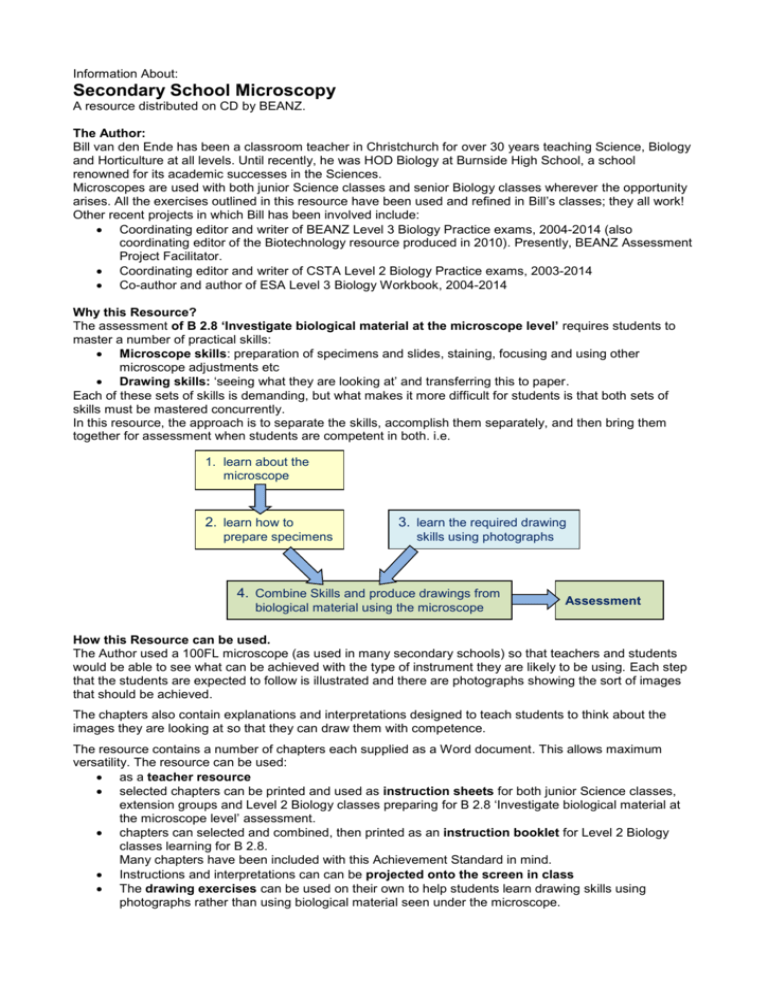
Information About:
Secondary School Microscopy
A resource distributed on CD by BEANZ.
The Author:
Bill van den Ende has been a classroom teacher in Christchurch for over 30 years teaching Science, Biology
and Horticulture at all levels. Until recently, he was HOD Biology at Burnside High School, a school
renowned for its academic successes in the Sciences.
Microscopes are used with both junior Science classes and senior Biology classes wherever the opportunity
arises. All the exercises outlined in this resource have been used and refined in Bill’s classes; they all work!
Other recent projects in which Bill has been involved include:
Coordinating editor and writer of BEANZ Level 3 Biology Practice exams, 2004-2014 (also
coordinating editor of the Biotechnology resource produced in 2010). Presently, BEANZ Assessment
Project Facilitator.
Coordinating editor and writer of CSTA Level 2 Biology Practice exams, 2003-2014
Co-author and author of ESA Level 3 Biology Workbook, 2004-2014
Why this Resource?
The assessment of B 2.8 ‘Investigate biological material at the microscope level’ requires students to
master a number of practical skills:
Microscope skills: preparation of specimens and slides, staining, focusing and using other
microscope adjustments etc
Drawing skills: ‘seeing what they are looking at’ and transferring this to paper.
Each of these sets of skills is demanding, but what makes it more difficult for students is that both sets of
skills must be mastered concurrently.
In this resource, the approach is to separate the skills, accomplish them separately, and then bring them
together for assessment when students are competent in both. i.e.
1. learn about the
microscope
2. learn how to
prepare specimens
3. learn the required drawing
skills using photographs
4. Combine Skills and produce drawings from
biological material using the microscope
Assessment
How this Resource can be used.
The Author used a 100FL microscope (as used in many secondary schools) so that teachers and students
would be able to see what can be achieved with the type of instrument they are likely to be using. Each step
that the students are expected to follow is illustrated and there are photographs showing the sort of images
that should be achieved.
The chapters also contain explanations and interpretations designed to teach students to think about the
images they are looking at so that they can draw them with competence.
The resource contains a number of chapters each supplied as a Word document. This allows maximum
versatility. The resource can be used:
as a teacher resource
selected chapters can be printed and used as instruction sheets for both junior Science classes,
extension groups and Level 2 Biology classes preparing for B 2.8 ‘Investigate biological material at
the microscope level’ assessment.
chapters can selected and combined, then printed as an instruction booklet for Level 2 Biology
classes learning for B 2.8.
Many chapters have been included with this Achievement Standard in mind.
Instructions and interpretations can can be projected onto the screen in class
The drawing exercises can be used on their own to help students learn drawing skills using
photographs rather than using biological material seen under the microscope.
To make these different approaches possible:
All chapters are supplied as WORD documents (.docx) so they can be edited if required.
All chapters are well illustrated with large full-coloured photographs, photomicrographs, diagrams
and drawings. The basic resource has over 140 pages and includes approximately 300 illustrations
(plus drawing exercises).
Contents
Many chapters are aimed directly at students undertaking B 2.8 ‘Investigate biological material at the
microscope level’.
Other exercises are ideas that teachers could incorporate into junior Science classes so students can gain
experience in using microscopes and allowing see the excitement that microscopes can bring to Biology.
The following is a list of the chapters contained in this resource:
Instructional chapters
o Cover page (for those wishing to produce a booklet resource within their school. There is room to
insert your school name and other details)
o Learning to use your microscope
o Exercises that will help you understand how your microscope works
o Preparing specimens for observation under the microscope
(These three chapters are provided in both senior and junior versions that differ in length and
complexity. This is to give a choice depending on the level of the class; Level 2 Biology or junior
Science)
o Student exercises (worksheet)
o How to make biological drawings
23 specimen preparation chapters:
o Cork cells
o Starchy tissues, Potatoes and Bananas
o Onion Epidermal cells
o Leaf Epidermal tears
o Elodea leaves
o Leaf Cross-sections
o Root Hairs
o Pollen and pollen tubes
o Human Cheek cells
o Insect Tracheoles
o Parthenogenesis in Aphids
o Fish Tail blood vessels (includes 8 video clips)
o Paramecium
o Protozoa – general
o Spirogyra
o Filamentous Green Algae
o Nitella
o Bread Moulds
o Yeast
o Yoghurt bacteria
o Looking at Chromosomes and Mitosis
o Plasmolysis and the effect of Osmosis on plant cells
o Microscope Safari
Six Drawing Exercises (specifically aimed at B 2.8):
o Onion Epidermal Skin cells
o Leaf Epidermal tears
o Leaf Cross-sections
o Human Cheek cells
o Paramecium
o Spirogyra
Copyright:
All rights are reserved. Purchasing schools can use this resource only within that school.
Individual teachers who purchase this resource can only use this resource in their classes.
Material can be copied onto the purchasing school’s intranet in a way that allows access from within the
school only.
Enquiries and feedback
Bill van den Ende
vandenende@xtra.co.nz








